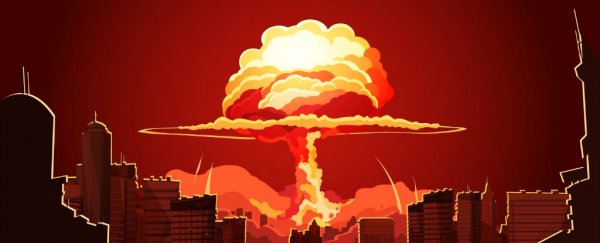On Wednesday, The Bulletin of the Atomic Scientists announced they have moved the Doomsday Clock forward so it now rests 2 minutes before midnight.
The Doomsday Clock is a symbol which represents the likelihood of a human-made global catastrophe. Ever since 1998, when India and Pakistan started testing nuclear weapons, the Doomsday Clock has been just single digits away from midnight.
But after the disaster that was 2017, when world leaders failed to respond effectively to looming threats of nuclear war and climate change, scientists have moved the minute hand forward by 30 seconds.
The Clock is now closer than it has ever been to Doomsday since the height of the Cold War in 1953.
"In 2017, we saw reckless language in the nuclear realm heat up already dangerous situations and relearned that minimising evidence-based assessments regarding climate and other global challenges does not lead to better public policies," said Rachel Bronson, the Bulletin's president and CEO.
According to the experts, last year's greatest threats came from the nuclear realm, leaving humanity on the "cusp of a new arms race".
North Korea's nuclear weapons progress and the "hyperbolic rhetoric and provocative actions" from both the US and North Korea have increased the possibility of nuclear war, they say.
Sharon Squassoni, a board member and international affairs expert at The George Washington University, says the lack of negotiation between the US and Russia, the tensions between Pakistan and India, and the controversy surrounding the Iranian nuclear deal also adds to the "bleak overall picture".
"With US-Russian relations so strained, there is little room for progress anywhere else," she noted at a press briefing.
For the first time in many years, in fact, no US-Russian nuclear arms control negotiations are under way. Great.
On the climate change front, things are also looking grim. Global carbon dioxide emissions continue to rise and the global response has fallen far short of meeting the challenge.
Meanwhile, powerful hurricanes have devastated the Caribbean and other parts of North America, extreme heat waves are sweeping Australia, South America, Asia, Europe and California, and the Arctic ice cap is the smallest it has ever been in winter.
But don't worry, there is still hope. After all, the Doomsday Clock is less a prophecy than it is a warning.
"We've made the clear statement that we feel the world is getting more dangerous," said physicist Lawrence Krauss of Arizona State University.
"We present the clock not so much as doom and gloom, but as an opportunity to get government and the public discussing the important issues."
So what do the scientists suggest we do?
The 2018 Doomsday Clock statement provides some common-sense answers, including:
- US President Donald Trump should refrain from provocative rhetoric regarding North Korea, recognising the impossibility of predicting North Korean reactions.
- The world community should pursue, as a short-term goal, the cessation of North Korea's nuclear weapon and ballistic missile tests.
- The Trump administration should abide by the terms of the Joint Comprehensive Plan of Action for Iran's nuclear program unless credible evidence emerges that Iran is not complying.
- The United States and Russia should discuss and adopt measures to prevent peacetime military incidents along the borders of NATO.
- The international community should establish new protocols to discourage and penalise the misuse of information technology to undermine public trust in political institutions, in the media, in science, and in the existence of objective reality itself.
We hope world leaders are paying attention because time is running out.
Science As Fact is our sister site where we cover politics, debunking, fact checking, and humour. If you want more like this, head over to Science As Fact.
